| Murder will Out! A Unpublished Manuscript by the late Glenn H. Waight |

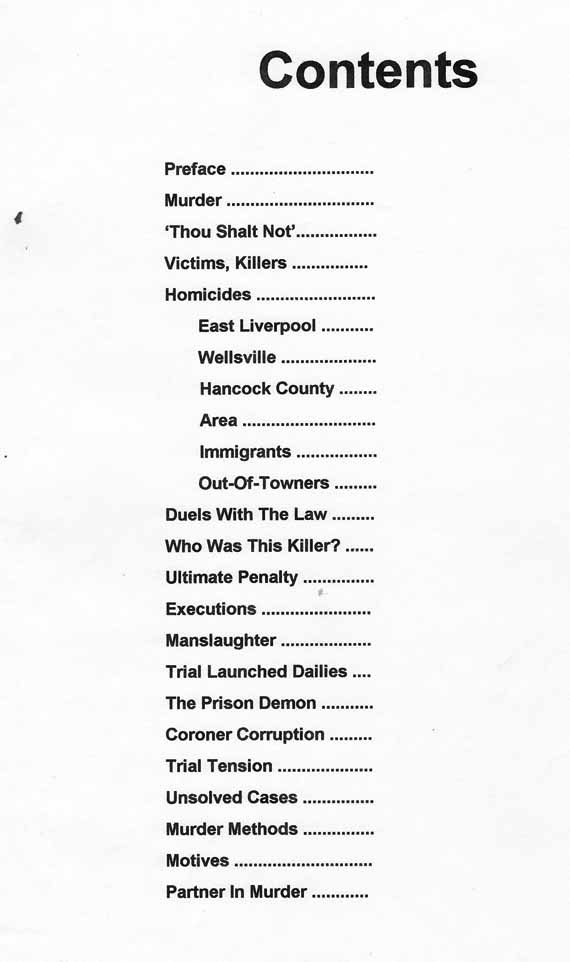
Murder Will Out --
Most Of The Time
During the past two centuries, the East Liverpool area has recorded several unusual homicides, differing from those resulting from common barroom assaults and street brawls.
Sensational crimes ranged from an attempt to hide an airplane inventor's murder and a wife's killing of an alleged abusive husband to two triple slayings and a bride's poisoning of six or more husbands.
Some of the killers were caught fortuitiously. Others were tracked down by diligent police work. At least,remain unknown and unpunished today.
Among still unsolved cases are those of inventor Christian Olsen in 1861; bar operator Steve Phillips in 1945; bride Alice Lyons who vanished the same year; newlywed Julia Wall whose body was found in a barrel; elderly Irvin Keefer shot in a 1976 holdup; and store owner Earl Tweed with Linda Morris and daughter butchered in 1973.
Other major murders ending in conviction were those of road contractor Richard Burrows, milkman Clarence Dickey, special officer Joseph Mumford, coin collector Willis Smith, dismembered Lynn Hanna, kidnapped witness Debra Pugh and young mother Debbie Taylor and her two children.
Here are accounts of those sorrowful crimes and others which shocked and fascinated the community in yesteryear.
Acknowledgments
Much of the material for this account was obtained from film files of East Liverpool newspapers -- The Mercury, The Tribune, The Crisis, The Gazette and The Review --plus clippings from the Cleveland Plain-Dealer, the Salem Republican and others.
Many newspaper clippings were provided by Joan Witt, city historian, and Richard Thompson of the East Liverpool Historical Society from collections of the late Jack Lanam.
Other sources ranged from a biography of Wellsville Police Chief John Fultz, written by his niece, to author Michael Wallis' "Pretty Boy" Floyd." Recollections of reporters, including my own memories of covering some trials, were supplementary, as were those of law officers, particularly the late Mayor William Devon, veteran city detective.
Personal thanks go to Joan Will for leading me to the Burrows murder case -- the seed for this survey of slaughter -- and for revelations about several slayings not on my original list.
Every writer is indebted for help with the final version of a manuscript -- guidance, suggestions, editing, correcting. I am obligated to Atty. Timothy Brookes, Gretchen Hemings, Charles Deitch and Lucille Huston.
(c) 1996 East Liverpool
Murder!
"Morder wol out, certyn, it wol not faille," wrote England's Geoffrey Chaucer (12431400) in "The Prioress's Tale" of his famed literary masterpiece, "Canterbury Tales."
Deliberately taking a human life "with malice aforethought" has-been considered mankind's worst evil. War, of course, is the exception, because killing then is seen justified as defense of country or religion, family and self.
But Judeo-Christian religion's Ten Commandments make murder a major offense against God. And criminal laws of civilized nations rank it first, and many require capital punishment.
That the bloody deed can not be hidden has long been a belief among men. The Lord knew the fate of Abel when he demanded of Cain, "What hast thy done? the voice of thy brother's blood cries unto me from the ground."
"Truth will come to light," declared William Shakespeare in his Merchant of Venice (1596-97), "murder cannot be hid long." Spanish author Cervantes coined the famous "Murder will out!" in his Don Quixote (Book Three, Chapt. 8).
John Webster commented in Duchess of Malfi' (1623), 'Other sins only speak, murder shrieks."
YET NO MATTER how morally vile, how repulsive to society, how torturing it must be to the perpetrator, it is a crime that has ever bloodied the rolls of civilization and tainted records of many good families.
The word itself comes partly from and Old English "morthor" and Latin "mort," meaning death and "mori" meaning to die. Under Ohio law, slaying a person is classified into (1) murder, killing another on purpose, and (2.) aggravated murder, either premeditated or involving a felony.
Premeditated murder involves a death with a studied scheme to kill.
In Ohio, felony murder involves a death connected with committing or attempting to commit or flee from a kidnapping, rape, arson, robbery, burglary or escape.
The penalty for straight murder is 15 years to life and a fine of from $15,000 to $50,000.
The penalty for aggravated murder ranges from life imprisonment to execution, and a fine of from $25,000 to $100,000.
WHY ARE MURDERS committed?
I have been indirectly involved with two murders -- once as an on-the-scene reporter in which an elderly retired potter shot and killed his 81-year-old wife.
When I was a soldier in Germany just before the end of World War II, I saw the corpse of a woman who had been raped and killed in one of the millions of brutally senseless non-military crimes connected with mankind's worst offense -- war itself.
In both of these I felt an overwhelming sadness -- for the dead wife and her bewildered spouse in the little Maplewood home and the pathetic conclusion of their lives, for the innocent war victim who escaped years of threatening death only to succumb to the cruelty of peace.
I also covered three Common Pleas Court murder trials at Lisbon, watching the tense defendants and sometimes gruesome evidence, listening to the often emotional witnesses.
People who take the lives of others are set apart in this world, not only in the legal sense, but in the moral and social and cultural attitudes of a community. Even lawmen and court officers hold a special regard for men and women whose hands bear the blood of victims. Hardened police and blase lawyers experience the same feelings as the rest of us, from revulsion and puzzlement to fear, uneasiness and even sympathy.
We ponder the true reason for their crime, whether a wild rage, a bitter frustration, a powerful resentment, a cold detachment, self-protection, overwhelming jealousy or a greedily clever plot,
Both the presumed-innocent suspect and the cursed convicted slayer are forever pariahs, separate from other humans, distrusted, pitied, embued with an aura of evil and mystery. Is he or she an agent or a victim of The Devil?
Ordinary citizens -- reluctant to trap a mouse or shoot a deer -- shrink from the thought of destroying a human, even in defense of family or friend.
Most of us are unable to imagine circumstances under which we could deliberately plan and execute the taking of another person's life. For many, even the idea of serving on a jury to decide the guilt and possible execution of a proven slayer is disturbing.
The thought of such a nightmarish act is reprehensible. Others may consider it in a lighter strain. Thomas DeQuincey (1785-1859) wrote,
If once a man indulges himself in murder, very soon he comes to think little of robbing, and from robbing he comes next to drinking and Sabbath- breaking, and from that to incivility and procrastination.
"Murder Considered As One of the Fine Arts" (1827)
During the 1970s several U.S. Supreme Court decisions made the death penalty unconstitutional if imposed without granting courts guideliness on the appropriateness of the sentence or if imposed for a crime that does not take or threaten a life. The decisions did not apply to treason or espionage.
After a 1972 high court ruling that all but a few capital statutes were unconstitutional, about 37 states revised and reenacted their death penalty laws. Since then the Supreme Court has upheld several such laws, and more than 200 executions have been carried out.
Ohio has not executed anyone since 1963, although the death penalty was reinstated in the Buckeye State and most other states in the late 1970s and early 1980s. By April 1997 there were 174 men on death row at the Mansfield Correctional Institution, some who have been waiting 14 years.
IN 1994 OHIO voters by a 70 percent margin approved removal of one layer of appeals available to those sentenced to die. Cases are now filed directly with the state Supreme Court from the trial court, bypassing the Appeals Court.
The General Assembly in 1995 adopted a law accelerating the appeals process for death row inmates challenging such issues as whether they had competent attorneys.
Congress in 1996 shortened the appeal process at the federal level by limiting how often a defendant can amend briefs filed in court.
In many states other rulings have since reduced curbs on executions. Opponents of the death penalty may be excused from murder juries, and accomplices in crimes leading to murder can face the ultimate punishment. It may also now be applied to mentally retarded or under age -- but at least 16 -- at the time of the crime.
More recently the court has cut back on the appeals a convicted killer may file to federal courts.
When Ohio's electric chair will again be used is uncertain due to pending appeals by convicted killers. [The electric was still the method of execution when Mr. Waight wrote this - webmaster] Gordon Reynolds, sentenced April 26, 1995, to die for murdering former girlfriend Lynn Hanna, filed an action with the Seventh District Court of Appeals.
That initial execution may be pivotal, since authorities expect a legal test on its validity from opponents of capital punishment.
The Death Penality Information Center at Washington, D.C., reports most executions since states reinstated capital punishment have been of those who have admitted their guilt, spurned the appeals process and asked to die.
IN 144 THE MURDERS described in this book, 20 victims were slain during robberies, twenty-six involved men killing their wives or other women, four were women slaying their husbands or boyfriends.
Seven were jealous men slaying other men, including an ex-husband gunning down his former wife and her lover in his bedroom.
Twenty-eight men killed other men for various reasons, and four law officers were murdered. A woman shot another woman, a mother murdered her own child, and two women were silenced to keep them from incriminating their slayers in other crimes.
Motives in most of the 25 unsolved murders are unknown.
Seventy-one of the 144 victims were shot, 25 were beaten, 11 strangled, 12 cut or stabbed and one died of poison. Three suspected victims died in fires. A woman was beaten then drowned.
ln 9 slayings, the killers committed suicide. In four others, suicide attempts failed. One man tried to kill himself after shooting a woman friend, was convicted and sent to prison. Several years later he wounded his common-law wife, killed her lover, then took his own life.
No one sentenced to death for murder in Columbiana has ever been executed. But one convicted killer who escaped jail and hanging shot himself when cornered, and several former area residents were hanged or electrocuted elsewhere.
Thou Shalt Not Kill'
Thirty-four unsolved homicides remain on the East Liverpool area's bloody crime rolls, clting back as far as 1861 and as recently as 1996.
This book lists the details of some 144 murders in that time frame along with several others for which information is very limited and final disposition uncertain.
We know much about these slaying from police reports, newspaper accounts, trial and hearing records. We read about the accusations, explanations, weapons, causes of death. We view photos of the victims and the killers, learn their ages, occupations, family backgrounds.
We are told the possible motives for why they pulled the trigger, thrust the knife, swung the blunt instrument," grabbed the throat, slipped the arsenic. Jealousy, anger, revenge, greed, fear, mental aberration, self defense, accident are claimed.
However, the search for truth is not satisfied in the courts. Recollections or interpretations of events by witnesses can be inaccurate, incomplete, deliberately misleading. The adversarial basis for prosecuting and defending a suspect often diverts or hides the truth. Laws of evidence and testimony sometimes prevent full disclosure of the facts.
The most seemingly sincere confession not always reveals the real purpose or explanation of why a life is taken, what dark intent or possibly honorable sacrifice drove the action, why a man or woman has assumed a terrible power that only God should wield.
It is noteworthy that in all these murders, vicious and horrendous as they were, we can find a reason, a link to a significant human behavior, ugly as it is. But the bloodshed differs from many of today's random, incomprehensible killings of innocent, uninvolved adults and children, caught in the evil, brainless actions of drug dealers, gang leaders and show-off youths.
This work is a tribute to the unfortunate victims, to the law officers who tracked down the guilty, and the attorneys, the judges and juries who struggled to serve the interests of justice.
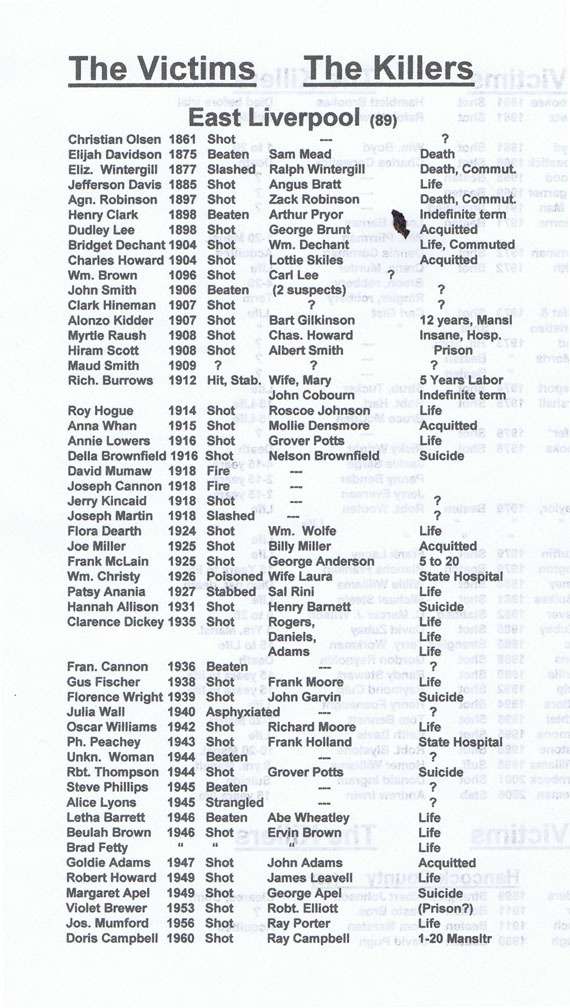
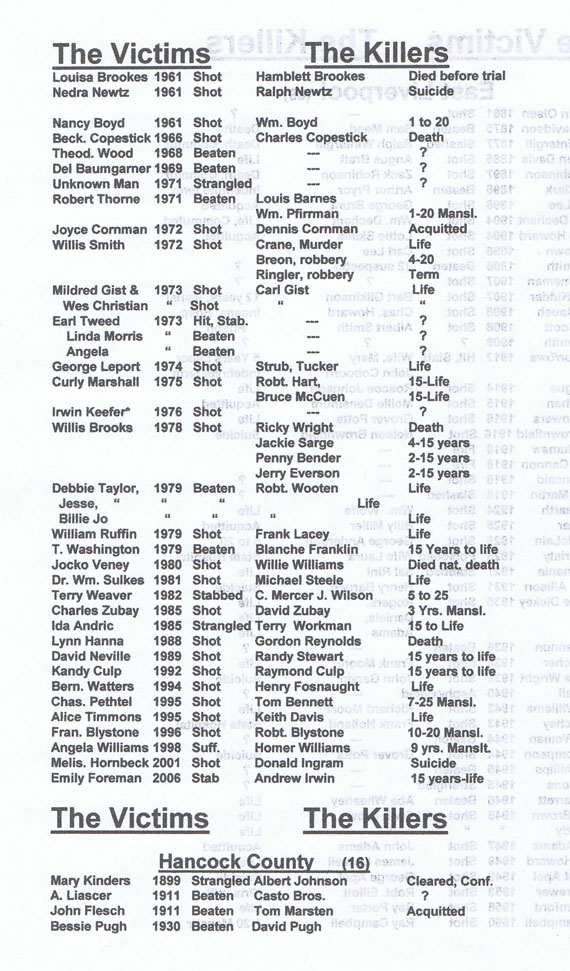
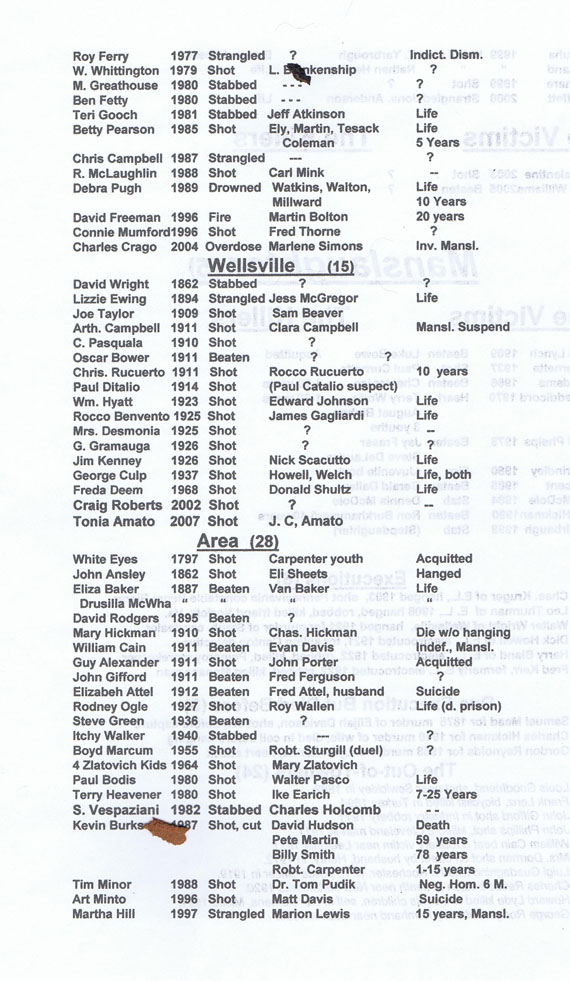
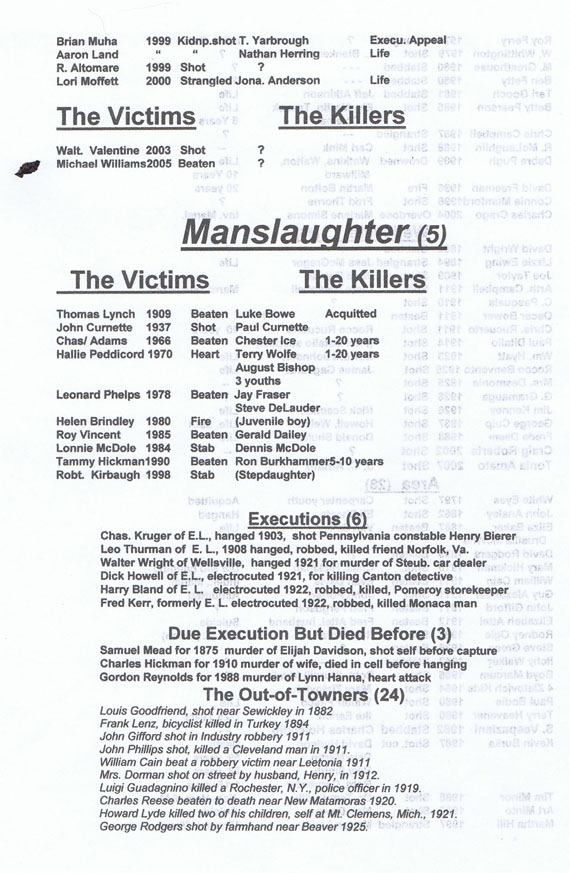
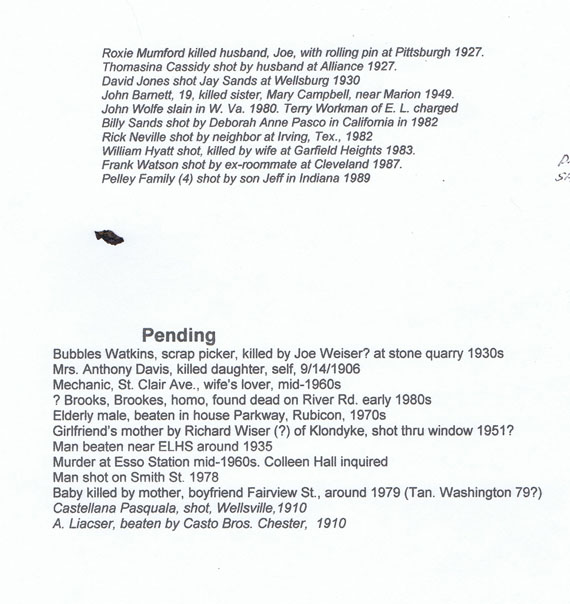
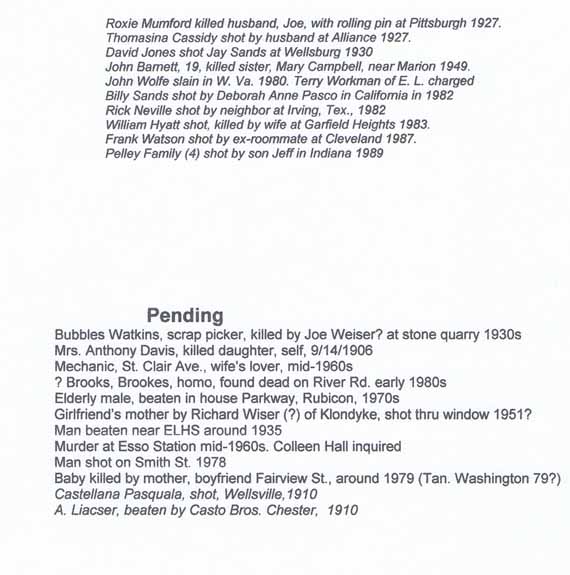
CONTINUE TO Murder Will Out 2
This site is the property of the East Liverpool Historical Society.
Regular linking, i.e. providing the URL of the East Liverpool Historical Society web site for viewers to click on and be taken to the East Liverpool Historical Society entry portal or to any specific article on the website is legally permitted.
Hyperlinking, or as it is also called framing, without permission is not permitted.
Legally speaking framing is still in a murky area of the law though there have been court cases in which framing has been seen as violation of copyright law. Many cases that were taken to court ended up settling out-of-court with the one doing the framing agreeing to cease framing and to just use a regular link to the other site.
The East Liverpool Historical Society pays fees to keep their site online. A person framing the Society site is effectively presenting the entire East Liverpool Historical Society web site as his own site and doing it at no cost to himself, i.e. stealing the site.
The East Liverpool Historical Society reserves the right to charge such an individual a fee for the use of the Society’s material.